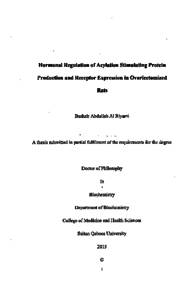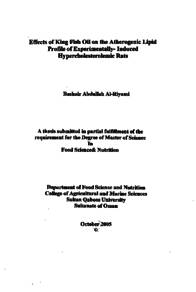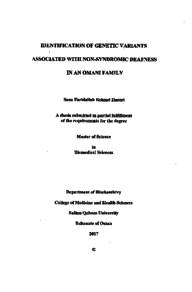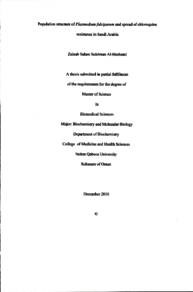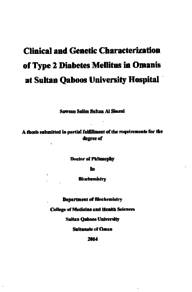Document
Hormonal regulation of acylation stimulating protein production and receptor expression in ovariectomized rats
Publisher
Sultan Qaboos University
Gregorian
2015
Language
English
Subject
English abstract
Background: Acylation stimulating protein (ASP) is a small protein isolated based on its function as a potent lipogenic factor. ASP, and its recently discovered receptor (C5L2), have been linked to obesity and several metabolic disturbances in humans and mice. Adipose metabolism is mediated through a complex network of hormonal signals including reproductive hormones. ASP was found to be strongly associated with female hormone alterations in vivo suggesting that ASP levels and function may be altered in association with sex hormone changes. Aim: In this study, we aim to investigate the effect of different hormone treatments on ASP levels in in vivo and ex vivo visceral and subcutaneous explant adipose tissue cultures. C5L2 expression will also be measured in subcutaneous and visceral fat depots in response to different hormone treatments. Furthermore, acute effects of different hormone treatments on postprandial AŞP levels after a fat load will be investigated. Methods: Ovariectomized (OVX) rats were divided into 5 groups (n=10) that received different sex hormone treatments for 2 weeks. Fasting plasma ASP levels and lipid profile were measured. ASP levels were measured in the media of subcutaneous and visceral explant tissue cultures to represent the microenvironment of ASP production. The expression of the C5L2 receptor in visceral and subcutaneous adipose tissue was measured by real time PCR, Postprandial ASP levels and lipid clearance were measured in ovariectomized rats divided into 4 groups including controls that were injected with a single dose of different sex hormone treatments. After one hour, a fat load (olive oil) was given, and plasma blood samples were collected at several time points for ASP and TG measurements. Analysis of variance (ANOVA) was performed to detect significant differences before and after and at different time points (within), and between hormonal treatments. Similar analysis was performed for analysing differences between subcutaneous and visceral fat tissue ASP production and receptor expression, Results: OVX rats had a significantly higher mean body weight than the sham counterparts with intact ovaries. Rat weights and TG levels in the OVX rats were shown to be largely influenced by hormone treatments, mainly estrogen which reduced the weights of the OVX rats and increased their TG levels reflecting a lipolytic effect resulting in decreased body weight and adipocyte cell size. The progesterone treated rats maintained their increased weight (due to ovariectomy), that was similar to the control weights and their TG levels also remained unchanged. Plasma ASP levels showed an increased trend with progesterone and P&E treatment and decreased with estrogen which did not reach significance. Interestingly however, plasma TG levels coordinated negatively with this ASP trend, most obvious in the estrogen treated group that showed the highest TG levels corresponding to the lowest ASP levels suggesting delayed TG clearance, while progesterone treatment showed lower TG levels reflecting enhanced TG clearance possibly due to increased ASP levels. In the quest to investigate hormone effect on direct ASP production from fat tissues of the treated rats in tissue cultures, ASP production from the P&E treated rats was the most pronounced (17% increase compared to controls, P<0.02, RM ANOVA). On the other hand, CSL2 receptor expression was markedly higher in the estrogen treated group (7 fold, P=0.034) compared to the controls and the progesterone treated group. In the postprandial study, the progesterone treated group had the highest significant postprandial ASP increase at two hours compared to basal levels and to the controls (439.8+ 62.4 vs 253.45€ 59.03 ug/ml), P=0.04. Interestingly, increased postprandial ASP levels coordinated negatively with corresponding TG levels further suggesting a role for progesterone in enhanced TG clearance. The findings of this study suggest that sex hormones may have a significant role in modulating ASP levels and corresponding TG levels affecting fat storage in vivo. Thereby, increased production of ASP appears to be mostly from subcutaneous adipose tissue influenced mainly by progesterone (in the presence of estrogen). On the other hand, increased ASP receptor levels in response to estrogen treatment may result from increased circulating TG levels which upregulated receptor expression and increased ASP binding, therefore decreasing plasma ASP levels. A reflection of these findings appears in the functional postprandial study, where progesterone enhanced ASP production and TG clearance in a simultaneous manner. The strong association of postprandial ASP levels and TG clearance in the progesterone treated group support the notion of a stimulatory role for progesterone on ASP mediated TG clearance. Conclusion: This is the first functional study to demonstrate a cause-effect relationship between hormone treatment and ASP levels in vivo. The overall findings are promising and may contribute to further understanding the mechanism of female hormones through enhancing ASP production and plasma levels.
Member of
Resource URL
Arabic abstract
المقدمة: بروتين تحفيز الأسيلة (ASP هو بروتين يعمل على تخزين الدهون في الجسم. و قد اكتشف مؤخرا مستقبل الى ASP في الخلايا الدهنية و يسمى C5L2. ارتبطت تغيرات ASP في الدم بالإصابة بالسمنه و العديد من الاضطرابات الأيضية في الإنسان و الفئران. تنظم العمليات الأيضية الدهنية من خلال شبكة معقدة من الإشارات الهرمونية و خصوصا الهرمونات التناسلية. وقد أشارت الدراسات إلى الارتباط القوي بين الى ASP و الاختلالات الهرمونية الأنثوية مما يشير الى تاثر مستويات ال ASP بهذه التغييرات الهرمونية. الهدف: يهدف هذا البحث إلى دراسة تأثير العلاج الهرموني على مستويات الى ASP في دم الفئران و الناتج من الأنسجة الدهنية المستأصلة من منطقة البطن و تحت الجلد. هدفت هذة الدراسة أيضا الى قياس المستقبل C5L2 تحت تأثير العلاج الهرموني في أنسجة الدهون تحت الجلد و في منطقة البطن. و هدف آخر وهو التحقق من التأثيرات الناجمة عن العلاجات الهرمونية المختلفة على مستويات ال ASP الوظيفية المرتبطة بتصفية الدهون بعد جرعة دهنية.
الطريقة: لتحقيق أهداف الدراسة تم تقسيم الفئران مستأصلة المبيض إلى 5 مجموعات و التي تلقت مختلف العلاجات الهرمونية التناسلية لمدة اسبوعين. بعد ذلك تم قياس مستويات ال ASP و الدهون في البلازما. وفي نهاية الدراسة تم استئصال و زراعة الأنسجة الدهنية المتواجدة في منطقة البطن و ما تحت الجلد من الفئران و قياس مستويات ال ASP الناتجة في سائل الأنسجة المزروعة لقياس مستوى مستقبل C5L2 في الأنسجة الدهنية تم استخدام تفاعل البوليمريز المتسلسل (g Real - Time PCR). وفي الدراسة الوظيفية (ما بعد الأكل) تم قياس مستويات ال ASP و معدل إزالة الدهون من الدم في الفئران مستاصلة المبيض حيث تم تقسيمها إلى 4 مجموعات بما فيهم المجموعة الضابطة و من ثم تم حقن الفئران بجرعة واحدة من الهرمونات الجنسية و بعدها بساعة تم اعطائها جرعة من زيت الزيتون. وفي أوقات مختلفة تم قياس مستوى ال ASP و الجليسرايدات الثلاثية (TG) في بلازما الدم. استخدم تحليل التباين (ANOVA) للكشف عن الفروقات و الاختلافات بين المجاميع. النتائج: أشارت نتائج الدراسة الى زيادة أوزان الفئران التي تم استئصال مبياضها مقارنة بالفئران الغير مستأصلة المبايض. و كانت مستويات ال TG و كذلك أوزان الفئران (OVX) قد تأثرت بشكل كبير بالهرمونات التناسلية المحقنة و خصوصا هرمون الإستروجين الذي كان له تأثير على إنقاص وزن الفئران و زيادة مستويات TG مقارنة بالمجموعة الضابطة. زادت مستويات الى ASP في البلازما مع هرمون البرجوسترون و E & P (هرموني الاستروجين و البروجسترون), في حين انخفضت مع هرمون الإستروجين. وجد أن مستويات ال ASP في المجموعة التي أعطيت هرمون الاستروجين قد ارتبطت سلبيا مع مستويات إلى TG و في المقابل وجد انخفاض في إلى TG في المجموعة التي أعطيت هرمون البروجسترون مما يشير الى تحفيز التخلص من ال TG بسبب ارتفاع مستويات ال ASP وقد بينت نتائج زراعة الأنسجة أن الهرمونات أثرت على مستويات أنتاج إلى ASP في الأنسجة الدهنية المعزولة من الفئران ووجد أن مستويات ال ASP كانت عالية مقارنة مع المجموعة الضابطة (حيث زادت بمعدل 17%). و في المقابل فإن مستقبلات C5L2 كانت أعلى في مجموعة الاستروجين مقارنه بالمجموعة الضابطة و مجموعة البروجسترون (7 أضعاف، 0 . 034 =P). وفي دراسة قياس معدل تصفية الدهون وجد أن مستويات الى ASP في المجموعة التي حقنت بهرمون البروجسترون كان أعلى بعد ساعتين من المجموعة الضابطة (62 . 4 + 439 . 8 مقابل 59 . 03 + 253 . 45 ميكروغرام/ مل , 0 . 04 = P).
و تشير نتائج هذه الدراسة إلى أن الهرمونات الجنسية (الاستروجين و البروجسترون) تلعب دورا مهما في تنظيم مستويات ال ASP و المرتبطة ب TGو التي تؤثر عموما على عملية تخزين الدهون في الجسم. و كان إنتاج الASP أعلى في الدهون المخزنة تحت الجلد و التي زاد إنتاجها تحت تأثير هرمون البروجسترون بوجود هرمون الاستروجين). وقد تسبب هرمون الإستروجين بزيادة تصنيع المستقبل C5L2 وقد يكون بسبب ارتفاع معدلات إلى TG و بالتالي زيادة ارتباط الى ASP بالمستقبل و انخفاض معدلاته في البلازما. وقد تمثلت هذه النتائج في دراسة (ما بعد الأكل الوظيفية , حيث ساعد هرمون البروجسترون على تحفيز انتاج ال ASP و تصفية الدهون.
الخلاصة: هذه هي أول دراسة وظيفية لإثبات العلاقة السببية بين العلاج الهرموني ومستويات ASP في الجسم الحي. هذه النتائج واعدة ويمكن أن تسهم في تعزيز فهم آلية الهرمونات الأنثوية من خلال تعزيز مستويات إنتاج ال ASP في البلازما.
الطريقة: لتحقيق أهداف الدراسة تم تقسيم الفئران مستأصلة المبيض إلى 5 مجموعات و التي تلقت مختلف العلاجات الهرمونية التناسلية لمدة اسبوعين. بعد ذلك تم قياس مستويات ال ASP و الدهون في البلازما. وفي نهاية الدراسة تم استئصال و زراعة الأنسجة الدهنية المتواجدة في منطقة البطن و ما تحت الجلد من الفئران و قياس مستويات ال ASP الناتجة في سائل الأنسجة المزروعة لقياس مستوى مستقبل C5L2 في الأنسجة الدهنية تم استخدام تفاعل البوليمريز المتسلسل (g Real - Time PCR). وفي الدراسة الوظيفية (ما بعد الأكل) تم قياس مستويات ال ASP و معدل إزالة الدهون من الدم في الفئران مستاصلة المبيض حيث تم تقسيمها إلى 4 مجموعات بما فيهم المجموعة الضابطة و من ثم تم حقن الفئران بجرعة واحدة من الهرمونات الجنسية و بعدها بساعة تم اعطائها جرعة من زيت الزيتون. وفي أوقات مختلفة تم قياس مستوى ال ASP و الجليسرايدات الثلاثية (TG) في بلازما الدم. استخدم تحليل التباين (ANOVA) للكشف عن الفروقات و الاختلافات بين المجاميع. النتائج: أشارت نتائج الدراسة الى زيادة أوزان الفئران التي تم استئصال مبياضها مقارنة بالفئران الغير مستأصلة المبايض. و كانت مستويات ال TG و كذلك أوزان الفئران (OVX) قد تأثرت بشكل كبير بالهرمونات التناسلية المحقنة و خصوصا هرمون الإستروجين الذي كان له تأثير على إنقاص وزن الفئران و زيادة مستويات TG مقارنة بالمجموعة الضابطة. زادت مستويات الى ASP في البلازما مع هرمون البرجوسترون و E & P (هرموني الاستروجين و البروجسترون), في حين انخفضت مع هرمون الإستروجين. وجد أن مستويات ال ASP في المجموعة التي أعطيت هرمون الاستروجين قد ارتبطت سلبيا مع مستويات إلى TG و في المقابل وجد انخفاض في إلى TG في المجموعة التي أعطيت هرمون البروجسترون مما يشير الى تحفيز التخلص من ال TG بسبب ارتفاع مستويات ال ASP وقد بينت نتائج زراعة الأنسجة أن الهرمونات أثرت على مستويات أنتاج إلى ASP في الأنسجة الدهنية المعزولة من الفئران ووجد أن مستويات ال ASP كانت عالية مقارنة مع المجموعة الضابطة (حيث زادت بمعدل 17%). و في المقابل فإن مستقبلات C5L2 كانت أعلى في مجموعة الاستروجين مقارنه بالمجموعة الضابطة و مجموعة البروجسترون (7 أضعاف، 0 . 034 =P). وفي دراسة قياس معدل تصفية الدهون وجد أن مستويات الى ASP في المجموعة التي حقنت بهرمون البروجسترون كان أعلى بعد ساعتين من المجموعة الضابطة (62 . 4 + 439 . 8 مقابل 59 . 03 + 253 . 45 ميكروغرام/ مل , 0 . 04 = P).
و تشير نتائج هذه الدراسة إلى أن الهرمونات الجنسية (الاستروجين و البروجسترون) تلعب دورا مهما في تنظيم مستويات ال ASP و المرتبطة ب TGو التي تؤثر عموما على عملية تخزين الدهون في الجسم. و كان إنتاج الASP أعلى في الدهون المخزنة تحت الجلد و التي زاد إنتاجها تحت تأثير هرمون البروجسترون بوجود هرمون الاستروجين). وقد تسبب هرمون الإستروجين بزيادة تصنيع المستقبل C5L2 وقد يكون بسبب ارتفاع معدلات إلى TG و بالتالي زيادة ارتباط الى ASP بالمستقبل و انخفاض معدلاته في البلازما. وقد تمثلت هذه النتائج في دراسة (ما بعد الأكل الوظيفية , حيث ساعد هرمون البروجسترون على تحفيز انتاج ال ASP و تصفية الدهون.
الخلاصة: هذه هي أول دراسة وظيفية لإثبات العلاقة السببية بين العلاج الهرموني ومستويات ASP في الجسم الحي. هذه النتائج واعدة ويمكن أن تسهم في تعزيز فهم آلية الهرمونات الأنثوية من خلال تعزيز مستويات إنتاج ال ASP في البلازما.
Category
Theses and Dissertations

